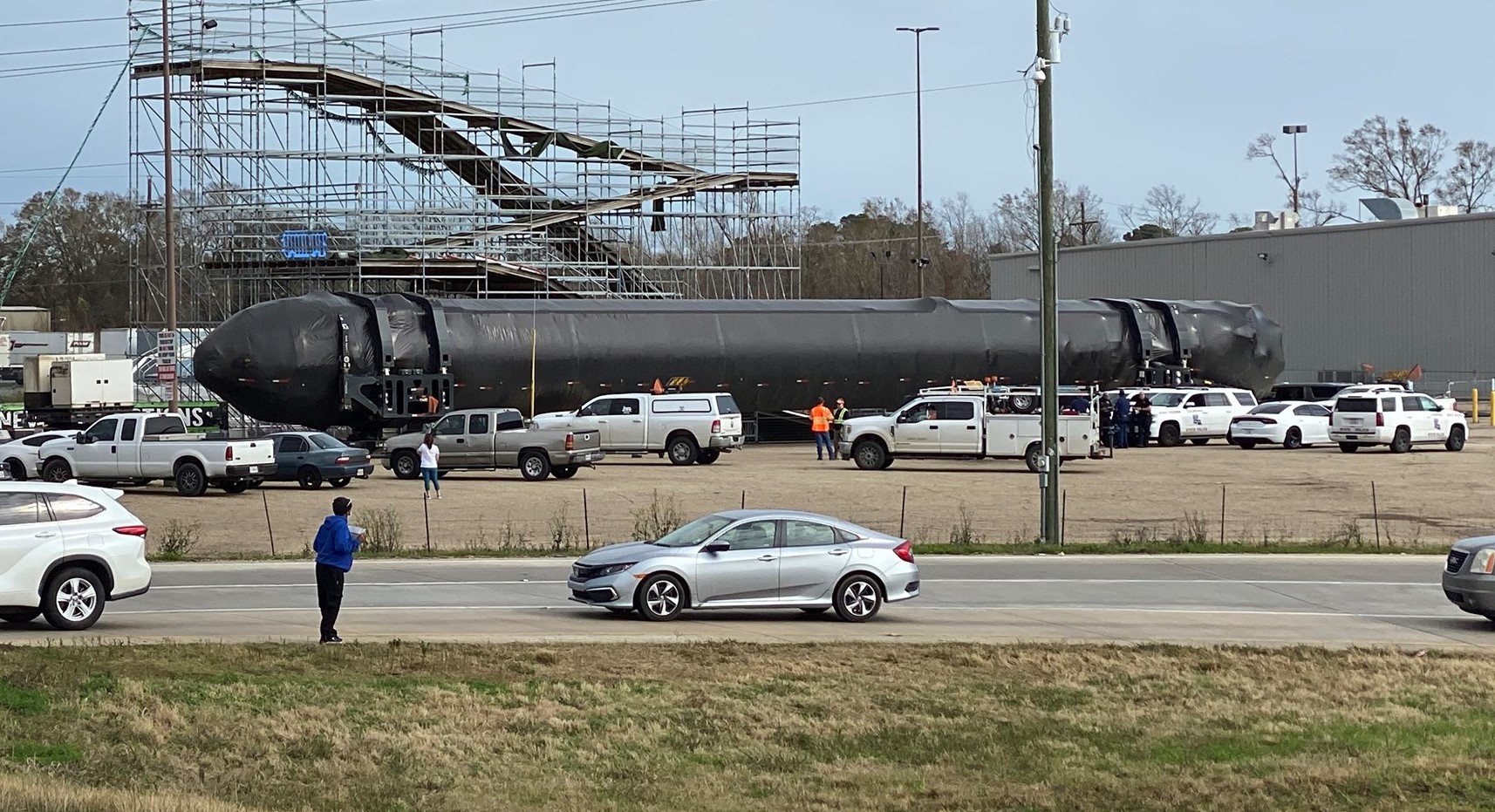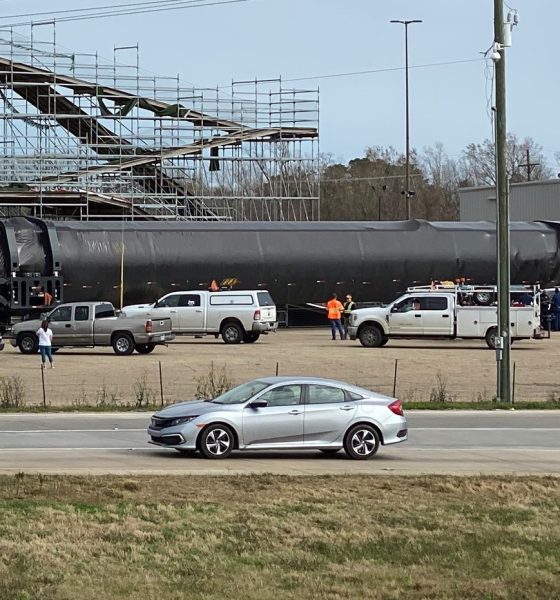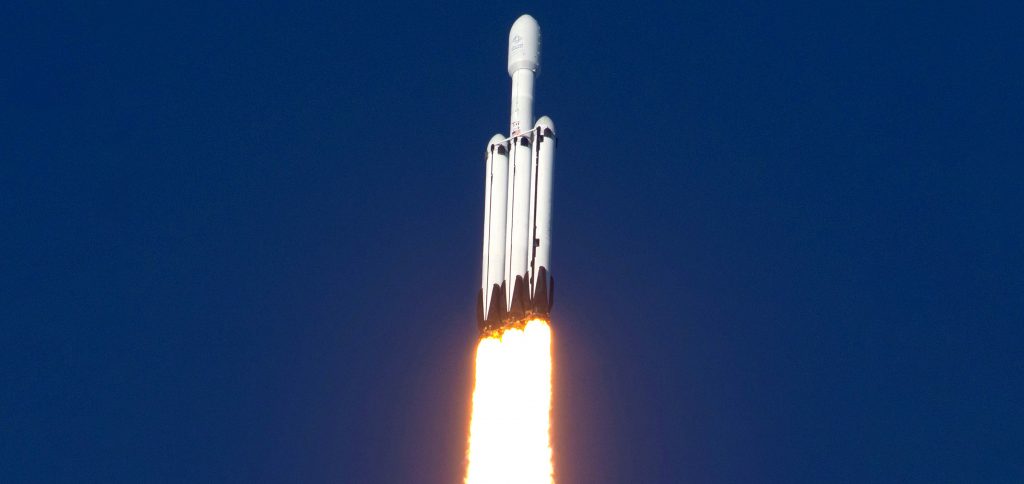

News
SpaceX begins Falcon Heavy booster deliveries for first launch in two years
SpaceX’s first Falcon Heavy rocket launch in almost two years has entered the final stages of preparations – flight hardware acceptance testing, delivery, and assembly.
Comprised of five major elements, the vast majority of the challenges of building and launching Falcon Heavy come from the rocket’s three first-stage boosters – each more or less equivalent to a single-core Falcon 9 booster. Falcon Heavy’s twin side boosters are by far the most visually recognizable sign of that similar-but-different nature thanks to the need for aerodynamic nosecones instead of a Falcon booster’s normal interstage (a hollow cylinder).
While easily recognizable, the center core is the most technically Falcon Heavy-specific part of SpaceX’s partially-reusable heavy-lift rocket, requiring a unique airframe relative to side cores, which are essentially Falcon 9 boosters with a few major add-ons. It’s one of those Falcon Heavy side boosters that was spotted traveling by road from SpaceX’s test facilities to a Florida launch pad on Tuesday, January 26th.
For unknown reasons, although SpaceX currently has two reused Falcon Heavy side boosters that flew a second time on the US Air Force’s own STP-2 mission, the company has manufactured all-new boosters – likely at the US military’s request – for the rocket’s fourth launch. Rebadged from AFSPC-44 to USSF-44, that mission will see SpaceX attempt its first-ever direct-to-GEO launch, nominally launching a several-ton mystery satellite directly into geostationary orbit (GEO).
The main challenge of direct-to-GEO launches is the need for a given rocket’s upper stage to coast for hours in orbit and then reignite after that multi-hour coast period. The direct launch profile also demands more delta-V (propellant) than alternative transfer orbits (GTOs) – propellant that must be launched into orbit in addition to the customer’s payload. That requires the use of extremely large and/or efficient rockets, which is why SpaceX is launching USSF-44 with Falcon Heavy instead of a much cheaper and simpler Falcon 9.

Unlike all other direct-to-GEO launches in history, however, Falcon Heavy Flight 4 will (hopefully) mark the first time a rocket launches a payload into geostationary orbit while still recovering a large portion of its first stage. After liftoff, Falcon Heavy side boosters B1064 and B1065 will attempt the first-ever dual drone ship landing at sea, while the rocket’s custom center core will be intentionally expended. According to CEO Elon Musk, that sacrificial-center-core configuration theoretically allows Falcon Heavy to achieve ~90% of its expendable performance while still recovering two otherwise reusable boosters.
As of the first USSF-44 side booster’s appearance in Louisiana, at least one other booster (most likely the mission’s second side booster) has already been spotted at SpaceX’s McGregor, Texas development facilities and may have already completed its own round of static fire acceptance testing. Given the three-month gap between the first USSF-44 side booster’s static fire and a side booster’s appearance in transport, there’s a distant possibility that the booster spotted on January 26th was the second of two side boosters to ship east, but that’s improbable given how much Falcon boosters stick out on the road.
Ultimately, assuming the second USSF-44 side booster’s static fire acceptance test went well, the only major Falcon Heavy-specific hardware SpaceX needs to ship from its Hawthorne, CA headquarters is center core B1066. An upper stage and payload fairing will also have to pass acceptance testing and head to Florida but both will likely be standard Falcon 9-issue hardware, minimizing small-batch uncertainty.
If SpaceX delivers B1066 to McGregor within the next week or two, the center core should be ready to ship to Florida by March or April, leaving SpaceX two or three months to integrate, static fire, and prepare Falcon Heavy for its fourth launch. According to the latest official information from the US military, USSF-44 is scheduled to launch no earlier than (NET) “late-spring 2021,” likely implying late-May or June.

Elon Musk
Elon Musk’s X will start using a Tesla-like software update strategy
The initiative seems designed to accelerate updates to the social media platform, while maintaining maximum transparency.

Elon Musk’s social media platform X will adopt a Tesla-esque approach to software updates for its algorithm.
The initiative seems designed to accelerate updates to the social media platform, while maintaining maximum transparency.
X’s updates to its updates
As per Musk in a post on X, the social media company will be making a new algorithm to determine what organic and advertising posts are recommended to users. These updates would then be repeated every four weeks.
“We will make the new 𝕏 algorithm, including all code used to determine what organic and advertising posts are recommended to users, open source in 7 days. This will be repeated every 4 weeks, with comprehensive developer notes, to help you understand what changed,” Musk wrote in his post.
The initiative somewhat mirrors Tesla’s over-the-air update model, where vehicle software is regularly refined and pushed to users with detailed release notes. This should allow users to better understand the details of X’s every update and foster a healthy feedback loop for the social media platform.
xAI and X
X, formerly Twitter, has been acquired by Elon Musk’s artificial intelligence startup, xAI last year. Since then, xAI has seen a rapid rise in valuation. Following the company’s the company’s upsized $20 billion Series E funding round, estimates now suggest that xAI is worth tens about $230 to $235 billion. That’s several times larger than Tesla when Elon Musk received his controversial 2018 CEO Performance Award.
As per xAI, the Series E funding round attracted a diverse group of investors, including Valor Equity Partners, Stepstone Group, Fidelity Management & Research Company, Qatar Investment Authority, MGX, and Baron Capital Group, among others. Strategic partners NVIDIA and Cisco Investments also continued support for building the world’s largest GPU clusters.
News
Tesla FSD Supervised wins MotorTrend’s Best Driver Assistance Award
The decision marks a notable reversal for the publication from prior years, with judges citing major real-world improvements that pushed Tesla’s latest FSD software ahead of every competing ADAS system.

Tesla’s Full Self-Driving (Supervised) system has been named the best driver-assistance technology on the market, earning top honors at the 2026 MotorTrend Best Tech Awards.
The decision marks a notable reversal for the publication from prior years, with judges citing major real-world improvements that pushed Tesla’s latest FSD software ahead of every competing ADAS system. And it wasn’t even close.
MotorTrend reverses course
MotorTrend awarded Tesla FSD (Supervised) its 2026 Best Tech Driver Assistance title after extensive testing of the latest v14 software. The publication acknowledged that it had previously criticized earlier versions of FSD for erratic behavior and near-miss incidents, ultimately favoring rivals such as GM’s Super Cruise in earlier evaluations.
According to MotorTrend, the newest iteration of FSD resolved many of those shortcomings. Testers said v14 showed far smoother behavior in complex urban scenarios, including unprotected left turns, traffic circles, emergency vehicles, and dense city streets. While the system still requires constant driver supervision, judges concluded that no other advanced driver-assistance system currently matches its breadth of capability.
Unlike rival systems that rely on combinations of cameras, radar, lidar, and mapped highways, Tesla’s FSD operates using a camera-only approach and is capable of driving on city streets, rural roads, and freeways. MotorTrend stated that pure utility, the ability to handle nearly all road types, ultimately separated FSD from competitors like Ford BlueCruise, GM Super Cruise, and BMW’s Highway Assistant.
High cost and high capability
MotorTrend also addressed FSD’s pricing, which remains significantly higher than rival systems. Tesla currently charges $8,000 for a one-time purchase or $99 per month for a subscription, compared with far lower upfront and subscription costs from other automakers. The publication noted that the premium is justified given FSD’s unmatched scope and continuous software evolution.
Safety remained a central focus of the evaluation. While testers reported collision-free operation over thousands of miles, they noted ongoing concerns around FSD’s configurable driving modes, including options that allow aggressive driving and speeds beyond posted limits. MotorTrend emphasized that, like all Level 2 systems, FSD still depends on a fully attentive human driver at all times.
Despite those caveats, the publication concluded that Tesla’s rapid software progress fundamentally reshaped the competitive landscape. For drivers seeking the most capable hands-on driver-assistance system available today, MotorTrend concluded Tesla FSD (Supervised) now stands alone at the top.
News
Elon Musk’s Grokipedia surges to 5.6M articles, almost 79% of English Wikipedia
The explosive growth marks a major milestone for the AI-powered online encyclopedia, which was launched by Elon Musk’s xAI just months ago.

Elon Musk’s Grokipedia has grown to an impressive 5,615,201 articles as of today, closing in on 79% of the English Wikipedia’s current total of 7,119,376 articles.
The explosive growth marks a major milestone for the AI-powered online encyclopedia, which was launched by Elon Musk’s xAI just months ago. Needless to say, it would only be a matter of time before Grokipedia exceeds English Wikipedia in sheer volume.
Grokipedia’s rapid growth
xAI’s vision for Grokipedia emphasizes neutrality, while Grok’s reasoning capabilities allow for fast drafting and fact-checking. When Elon Musk announced the initiative in late September 2025, he noted that Grokipedia would be an improvement to Wikipedia because it would be designed to avoid bias.
At the time, Musk noted that Grokipedia “is a necessary step towards the xAI goal of understanding the Universe.”
Grokipedia was launched in late October, and while xAI was careful to list it only as Version 0.1 at the time, the online encyclopedia immediately earned praise. Wikipedia co-founder Larry Sanger highlighted the project’s innovative approach, noting how it leverages AI to fill knowledge gaps and enable rapid updates. Netizens also observed how Grokipedia tends to present articles in a more objective manner compared to Wikipedia, which is edited by humans.
Elon Musk’s ambitious plans
With 5,615,201 total articles, Grokipedia has now grown to almost 79% of English Wikipedia’s article base. This is incredibly quick, though Grokipedia remains text-only for now. xAI, for its part, has now updated the online encyclopedia’s iteration to v0.2.
Elon Musk has shared bold ideas for Grokipedia, including sending a record of the entire knowledge base to space as part of xAI’s mission to preserve and expand human understanding. At some point, Musk stated that Grokipedia will be renamed to Encyclopedia Galactica, and it will be sent to the cosmos.
“When Grokipedia is good enough (long way to go), we will change the name to Encyclopedia Galactica. It will be an open source distillation of all knowledge, including audio, images and video. Join xAI to help build the sci-fi version of the Library of Alexandria!” Musk wrote, adding in a later post that “Copies will be etched in stone and sent to the Moon, Mars and beyond. This time, it will not be lost.”








